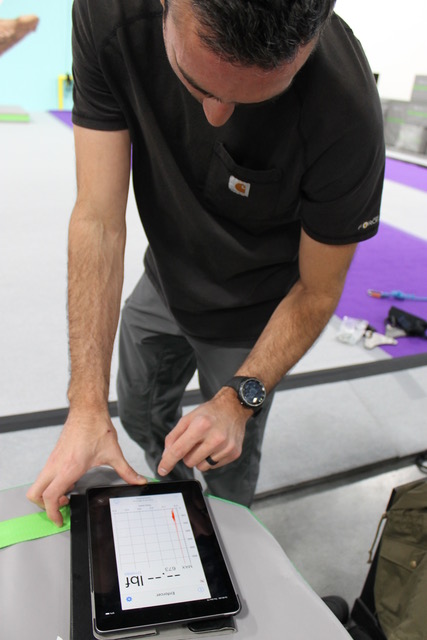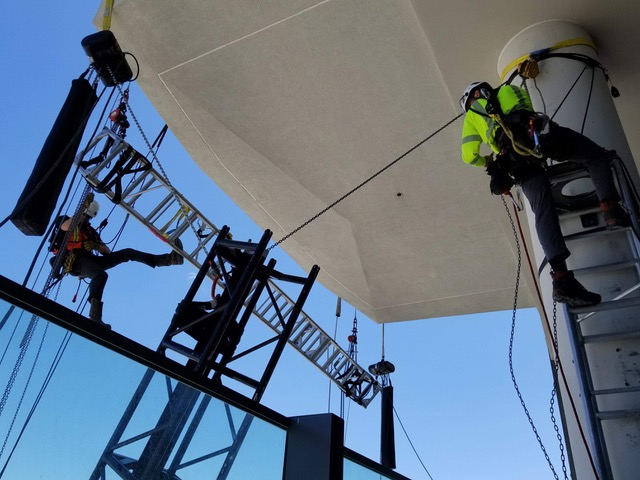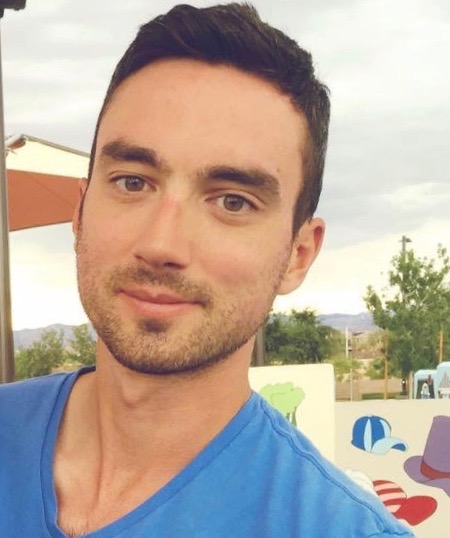
TheatreArtLife has connected with a number of Entertainment Riggers across the globe to bring you their stories, experience and advice on the very crucial roles and responsibilities Riggers hold in today’s industry. Trevor Whipkey joins us as a TheatreArtLife Contributor and begins his article collection by sharing his fascinating journey into the rigging industry.
When I graduated high school back in 2004, I didn’t have any idea about rigging or rope access or any experience in entertainment. My plan was to do my four years of college and then be a teacher and follow the path that gets beat into our heads from elementary school. I was attending the University of Kansas in Lawrence working on a degree in Behavioral Science when one day my friends and I decided to go see the local psychic on Mass Street.
I walk in and sit down with a large amount of skepticism. I introduce myself and then she starts talking about my future and all of this spooky stuff. She told me a whole bunch of stuff that never happened but she also told me three things that did.
1.) You’re going to have an uncle offer you a job.
2.) You’re going to move west at the end of the year.
3.) You’re going to experience a career path change that will be very rewarding.
My friends and I leave the place and carry-on about our day thinking we had just got ripped off by this lady. About a month later, I was sitting at my computer and I get an e-mail from my uncle in Vegas who was the OPM at “O” at the time. My jaw dropped to the floor when he offered me an internship in that e-mail. A few months later (at the end of the year) I moved to Vegas and began that new career she mentioned shortly after.
During the internship, I worked in the carpentry, automation and rigging departments for a month each. Shortly after the internship ended, I was hired as a Rigger at “Viva Elvis” and have been involved with rigging and work-at-height for nearly the past decade.

All of my training was on the job with Cirque du Soleil so I got to learn as I went. Theatrical/acrobatic riggers are a rare breed and very few places can duplicate the environment of a high-end production so there’s not a lot of options out there for training. Much of being a good rigger is finding out answers on your own and just wanting to learn.
I am a co-owner of a rope access company that offers aerial rigging courses as well as rope access and rescue courses for professional riggers so I’m constantly making training material, keeping up with industry norms and practices and picking through regulation and standards.
I was lucky enough to be hired on Corteo by Cirque du Soleil when it was under the big top. I was still very green when I started rigging this show and it turns out that I was going to Rigging University. The head rigger did a great job of creating a culture within the rigging crew of teaching and learning.
The crew was really experienced. There were two IRATA 3’s on the team, guys from the arena rigging world and other guys with heavy industrial experience. I spent a year and a half chasing these guys around and picking their brains. Beyond the professional experience of touring, the personal experience was just as comparable. One of my friends once said, “Get out in the world and let it teach you some lessons” and that’s exactly what happened. Each new city meant new challenges, new languages, new food and new experiences.
There’s two things I learned early on in my career.
1.) The safest riggers are the ones that last the longest. I used to tell people when we were training cue tracks that I didn’t care if we had to slow down an act or stop the show, just don’t scare anyone.
2.) As long as I kept my ears open and mouth shut, I’d be ok. This approach still works to this day. What I mean by that is have a good attitude. Be easy to work with, help the team and make yourself valuable.

The first step is to qualify yourself. Take a rope access class, take a fall protection class and learn how to work safely. The next step is to start applying with local unions, labor companies or theatrical production companies. In certain markets there’s a heavy demand for riggers so typically arena rigging is the easiest place to start.
There are other industries that have relatable skills such as energy production, engineering inspections and trade work such as pipefitting or fiberglass repair. If you’re working as a freelance rigger this is a great way to diversify and gain skill that will translate well into the entertainment world. In reality, most of entertainment rigging is taken from the industrial world and adapted for entertainment.
I’m not sure I have a typical day on the job these days because I’m working on so many different projects. Last month we were doing some install work on wind turbines in Texas, a couple of weeks ago we were in Minnesota doing a site visit for 7 miles of blackout curtain installations and next week we’re doing some work on motors in an arena in Detroit.
There are a few things that are common to all of these projects and that’s safety. Each day starts off with a hazard analysis where we identify risks, figure out how to mitigate them and come up with our rigging and rescue plans.
This discussion is usually followed by a tool box talk with safety issues relatable to the task at hand. After that we’ll do equipment inspections and get to work.
Venicio Vazquez – Venicio taught me my first cue track at Viva Elvis. He comes from a big circus family with a history of performing and has been doing this stuff his entire life. I worked with him again on the Michael Jackson ONE creation and picked up so many little tips and tricks to make life easier, to get things done a little faster and most importantly, how to keep myself safe. Beyond that, Venicio is one of the best guys you’re going to meet and still a good friend.
Joe Swain – Joe was one of the riggers on Corteo and is kind of like this wacky, whimsical guy from the U.K. I started watching him rig, the way he moved, the way he operated and his attention to detail and was sort of star struck. It was sort of like being a kid and seeing your favorite baseball player for the first time. Joe is one of the best rope technicians in the world and for some reason he liked me.

He was always happy to explain things and recognized the teachable moments. I learned more from Joe than probably about anybody. I think the biggest lesson I learned from Joe was about kindness. Every day, he would come to work and all he wanted to do was make people laugh and brighten their day and he usually succeeded. We had a day off in Antwerp once and so I knock on Joe’s door to go out and mess around the city. Joe opens the door with a wizard hat on, a Mary Magadelene dress, Spider-Man pajama pants and a $2000 leather jacket. On the way out the door he picked up a broken stick and spent the rest of the day casting spells on people around the city.
Nuno Cardoso – Nuno is another rigger from Corteo. He was kinda like that dad that was always watching over your shoulder, he somehow saw everything all at once. Nuno is one of the best teachers I’ve worked with. After shows we would all huddle up to talk about any issues and Nuno always had a long, long list from every show. The knowledge and solutions he shared in those meetings was incredible. Every night I was learning something from him but most importantly he challenged me. He’d let me figure things out up until the point of frustration and then give me the little bits of info I was missing. Another thing I learned from Nuno is that Portugal is the best country in the world (he’ll tell you).
Downtime? My wife, Noemie, and I have three kids so when I’m not at work, I’m at home and really at work.
Link to Trevor’s Website:
Inside The Lives Of Entertainment Riggers: Tora La Rosa
Inside The Lives Of Entertainment Riggers: James Busby


Trevor started a career in rigging after completing an internship with Cirque du Soleil. He was hired as an on-call Rigger at "Viva Elvis". After a year as an on-call, he was hired to tour with "Corteo" on the European leg of the tour. As a young rigger, for Trevor, this show was like going to university. It was full of professional and personal challenges that became some of the most influential moments of his life. In 2012, Trevor was hired to do the creation of Michael Jackson "ONE" in Vegas. Currently, Trevor spends his time bouncing back and forth between rope access projects on stadiums, bridges and wind turbines and work-at-height training. He owns a company called Rope Technologies based out of Las Vegas and they teach riggers how to work-at-height safely. Trevor's goals are to push the overall safety of work-at-height industries with a specific focus on theatrical safety. Trevor is married Noemie Dube-Dupuis and has 3 kids, Lola, Theo and Mila. They reside in Las Vegas. Qualifications: SPRAT 3/Trainer IRATA 3 ANSI Z359.2 Competent Rescuer/Trainer First-Aid, CPR, AED OSHA 30 ASNT Visual Testing I & II Key Projects: Cirque du Soleil’s “Viva Elvis”- Rigger Cirque du Soleil’s “Corteo”- Rigger Cirque du Soleil “Michael Jackson ONE” Creation Team- Rigger
Read Full Profile© 2021 TheatreArtLife. All rights reserved.

Thank you so much for reading, but you have now reached your free article limit for this month.
Our contributors are currently writing more articles for you to enjoy.
To keep reading, all you have to do is become a subscriber and then you can read unlimited articles anytime.
Your investment will help us continue to ignite connections across the globe in live entertainment and build this community for industry professionals.